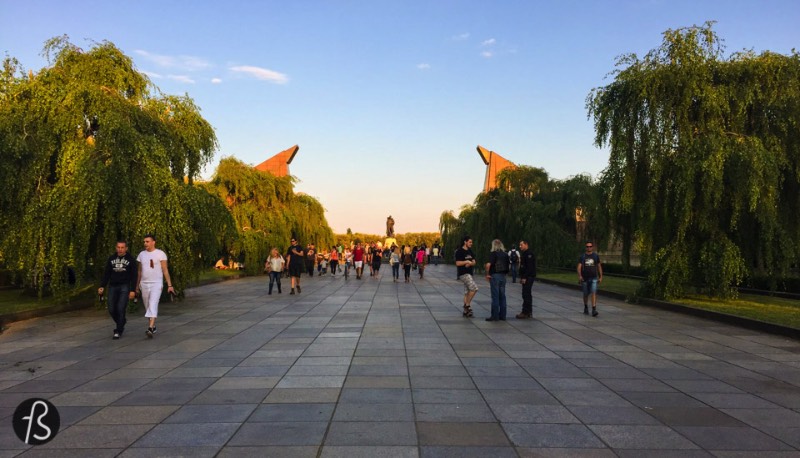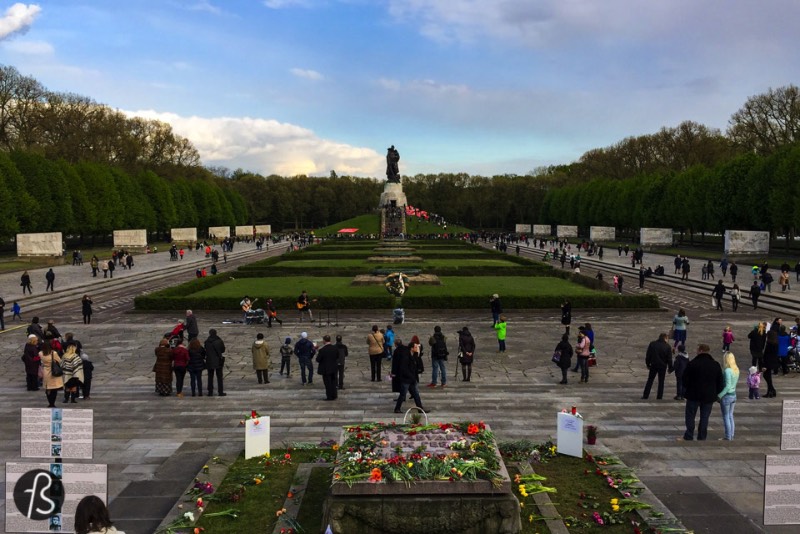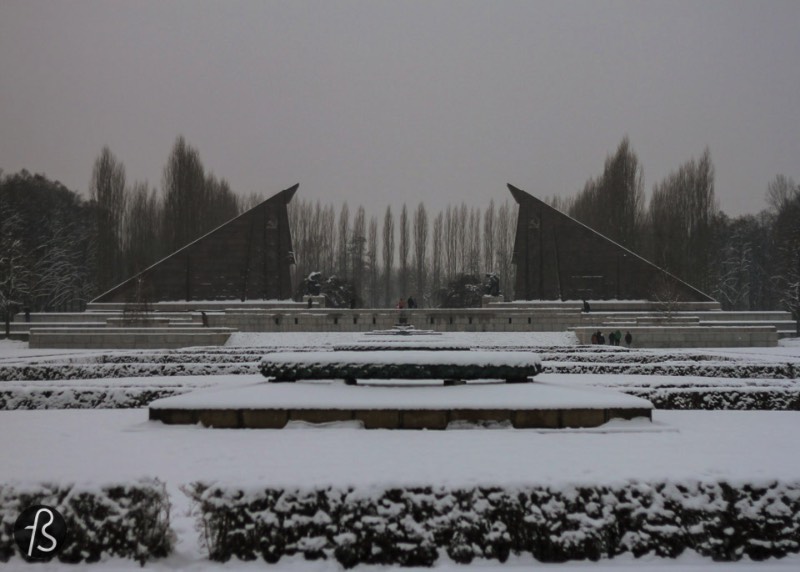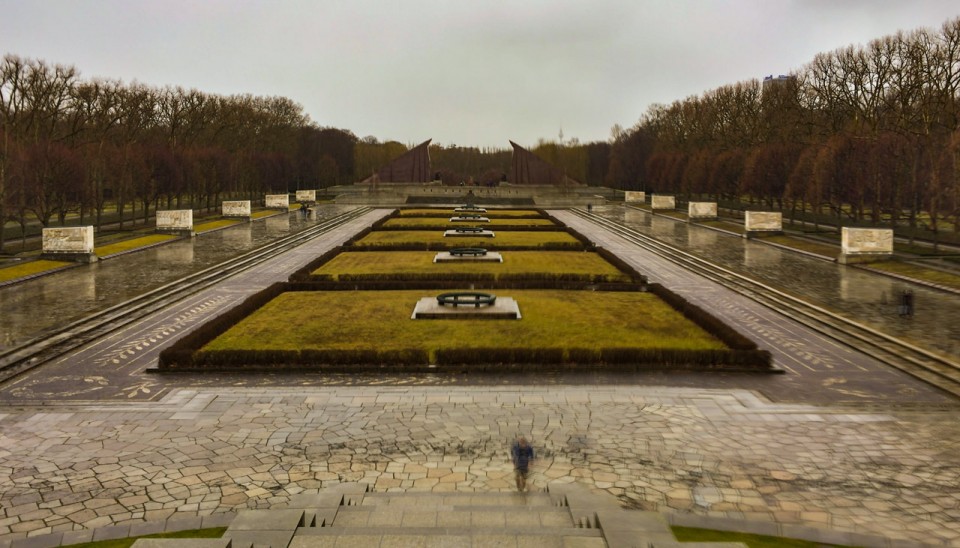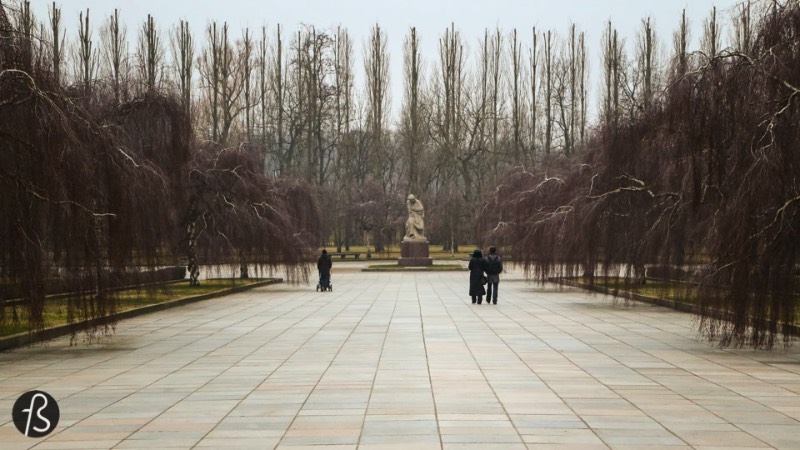Most visitors to Berlin, even those curious about World War II history, miss one of the city’s greatest, most curious, and most impressive memorials, the Soviet War Memorial at Treptower Park. Treptower Park just might be the most impressive and important war memorial you have never heard of, demonstrating how a monument can both educate and facilitate reflection. This memorial also reveals how a nation can accept—and, in the case of Germany, has accepted—that its own defeat was for the greater good of humankind.
<div class=”aligncenter”><!– Go to www.addthis.com/dashboard to customize your tools –> <div class=”addthis_native_toolbox”></div></div>
Further, it reminds visitors of the tremendous sacrifices incurred by Soviet Russia. Even nearly three decades after the collapse of the Soviet Union, Russians still call WWII the Great Patriotic War which remains deeply enshrined in their consciousness. Berlin’s Treptower Park allows people to learn about and empathize with Russians, a worthy endeavor during a time of renewed tension between Russia and the West.
A little bit of history from the Soviet War Memorial in Berlin’s Treptower Park
After World War II, the four leading European Allies militarily occupied and temporarily divided both Germany and its capital, Berlin. In 1949, as the Cold War escalated, Britain, France, and the United States united their zones and created the Federal Republic of Germany, popularly known as West Germany. Pushed by the United States and without the vote of the German people, the formation of West Germany was believed necessary as a bulwark against potential Soviet threats. The Soviets, enraged, quickly created the Democratic Republic of Germany or East Germany. So, too, in Berlin where the Western Allies’ three zones became West Berlin—officially part of West Germany despite being one hundred miles from the rest of that nation.
Joseph Stalin, leader of the Soviet Union, soon responded to what he saw as a Western provocation by closing all land access to West Berlin. The United States, United Kingdom, and other allies undertook the famous Berlin Airlift which lasted about eleven months before Stalin relinquished. Tensions de-escalated, a bit, but heightened in 1961 when East Germany constructed a nearly one-hundred-mile wall around West Berlin, primarily to prevent East Germans from escaping to “the West” rather than keeping West Berliners out of the East.
On May 8, 1949, just days before the Berlin Airlift ended and on the fifth anniversary of the Nazi surrender, the Soviets unveiled its Treptower memorial. Located in a large park in an East Berlin neighborhood, now called Alt-Treptow, it memorializes the 80,000 Soviet soldiers who died in the massive Battle of Berlin in April-May 1945 (in which 150,000 Germans also died).
The Soviet War Memorial is appropriately monumental and awe-inspiring. Russian artist Yeveny Vuchetich, the lead designer, combined sculpture, landscaping, and architecture to create an enormous monument commemorating the Soviet victory in the largest and bloodiest war in world history. Though the focus is on ordinary soldiers and citizens—this genre is named Socialist Realism—to many, it understandably feels Stalinist.
The memorial covers more than 22 acres. One walks into the park, from one of two streets, through large stone archways. Several hundred feet later stands a 10-foot high statue of a woman who, presumably, has lost a son, husband, or other loved one. “Mother Homeland” is encircled, on one side, by large willow trees. Turning around, one’s eyes immediately come upon two 50-foot high red granite blocks that are highly-stylized Soviet flags. In the extreme distance stands the rest of this epic monument.
Weeping birch trees flanking both sides, visitors walk between two immense statues of Soviet soldiers, each with a machine gun, medals pinned to their chests, and on bended knees. These flank the entrance into the memorial’s main section. One walks down a handful of steps where five, large sections of lawn with identical stone monuments adorning each. Underneath these fields lie about 7,000 Soviet soldiers who died during the Battle of Berlin. On either side of these mass graves, to reach the raised mausoleum at the end, stand eight large limestone blocks with relief sculptures celebrating the heroism of Soviet soldiers and citizens, men and women. These sarcophagi are inscribed with quotes from Stalin in Cyrillic and German (there are no English translations).
Finally, after walking about 500 feet, one approaches Treptower’s central feature. Walking up a series of steep, granite steps, one gazes up at the solitary figure of a Soviet soldier, standing almost 40 feet high. As the statue rests atop a mausoleum that itself is upon a small hill, all told the statue stands about 100 feet above the mass graves. A child rests in one of this heroic everyman’s arms; in his other, a sword points downward. Beneath his feet, the broken remains of a Nazi swastika.
In 1949 and for another eighteen years, Treptower Park was the world’s largest war memorial. In 1967, the Soviets unveiled an ever-larger one, to its epochal victory at Stalingrad. About 1,500,000 humans were killed and wounded there, the bloodiest battle in the history of the world. Unlike Treptower Park, though, “To the Heroes of the Stalingrad Battle” lies on Russian soil.
In 1990, East and West Germany reunited, the symbolic—and, to many, real—end of the Cold War. Before formally reunifying, East and West Germany signed an agreement with the four countries that had occupied Nazi Germany. Among other aspects, Germany agreed to maintain Treptower Park and other Soviet memorials despite being testaments to German defeat. Germany has lived up to its obligations, thus far, including major renovations of Treptower.
Treptower Park can play an important role in educating locals and visitors about the complicated history of World War II and the fight against fascism. The memorial also highlights the Soviet Union’s central role in defeating the Nazis. Not only did the Soviet Union play the leading role in defeating Germany, over 26,000,000 of its people (soldiers and civilians) were killed.
Treptower Park also can help visitors appreciate how Germans have tried to accept—rather than forget—its most terrible era, of Nazism. For that matter, the Japanese also could learn from the German approach to WWII.
Treptower has no parallel. Consider if the victorious People’s Republic of Vietnam built a memorial to its millions of dead in Washington, DC, the capital of the United States, and the American people paid to maintain it? Truly, that is hard to imagine but gives a sense of contemporary Germany’s commitment to atone for its past.
No doubt, Treptower Park is a Stalinist spectacle but it also serves as a testament to the sacrifice of millions who lost their lives. While stone statuary cannot bring the visceral feel that films can, Treptower Park does not disappoint. Treptower Park educates in a quieter, potentially more illuminating, way.
An earlier version of this essay appeared in History News Network.
Soviet War Memorial in Berlin’s Treptower Park
Puschkinallee, 12435 Berlin
Peter Cole is a Professor of History at Western Illinois University. He is the author of Wobblies on the Waterfront: Interracial Unionism in Progressive-Era Philadelphia (2007) and Dockworker Power: Race and Activism in Durban and the San Francisco Bay Area (forthcoming in 2018). He has been lucky enough, the past few summers, to have lived in Berlin, just a short distance from Treptower Park. He tweets from @ProfPeterCole
<div class=”aligncenter”><!– Go to www.addthis.com/dashboard to customize your tools –> <div class=”addthis_native_toolbox”></div></div><!– Go to www.addthis.com/dashboard to customize your tools –><br /><br /><!– –><div class=”addthis_recommended_horizontal”></div>
